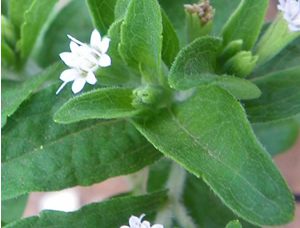
MinerAlert

MinerAlert
Stevia rebaudiana
Asteraceae
Sweet herb, sweet herb of Paraguay, caá-ehe, candy herb

This small perennial shrub is native to South America, principally Brazil and Paraguay.
Leaves.
Stevia leaves have been used as a natural sweetener for centuries by indigenous peoples (in especially Paraguay) of South America. Stevia has been used for decades as a non-caloric sweetener for various foods and beverages, especially in Japan, as well as other countries in the Orient (Khan and Abourashed, 2010; Mabberley, 2008). Commercially, Stevia is available as an extract and in powdered form. The fresh or dried leaves can be taken as a tea.
The leaf juice has hypotensive actions and is used against high blood pressure. A tea made form the leaves is used in Paraguay to treat diabetes as well as a contraceptive (Quattrocchi, 2012; Khan and Abourashed, 2010). Stevia leaves are a source of a natural non-caloric, and non-cariogenic (does not cause dental “cavities”) sweetener (Ferrazzano et al., 2015; Gamboa and Chavez, 2012). The leaves contain diterpene glycosides, commonly known a steviosides, which are approximately 300 times as sweet as sucrose or up to three fifths as sweet as saccharine (Khan and Abourashed, 2010; Mabberley, 2008). Stevioside and rebaudioside A are the two most abundant and better-analyzed compounds contained in the leaves, although more than 30 other steviol glycosides have been discovered (Wölwer-Rieck, 2012).
Ritu and Nandini (2016) undertook a study to assess the blood glucose lowering and lipid- lowering effects of a Stevia leaf powder on Type 2 diabetic patients. Additionally, the study evaluated the plant’s use as a sweetener, as well as its nutritional status. The results of the study revealed that the herb is nutritious and possesses an appreciable iron and fiber content. The authors concluded that Stevia is safe to use as an anti-diabetic plant, as well as a sweetener, and may additionally help to prevent cardiovascular complications in Type 2 diabetic patients.
Shivanna et al. (2013) studied the effects of Stevia leaves as well as a polyphenolic extract and fiber on streptozotocin- induced diabetic rats. The authors hypothesized that supplementation of polyphenols extract from Stevia to the rats’ diet would cause an amelioration of diabetes and its comorbidities (health complications). The results of the study showed that, aside for its anti-diabetic effects, the compounds contained in the leaves also possessed an important role in alleviating liver and kidney damage in the STZ-diabetic rats.
Various research studies have shown that Stevia contains various phytochemical compounds, known as steviosides and related ingredients, such as rebaudioside A and isosteviol, among others. These active ingredients may also possess additional beneficial therapeutic effects, including anti-diabetic, anti-hypertensive, anti-inflammatory, anti-cancer, anti-diarrheal, diuretic, and immune-modulatory activities. Aside from above mentioned properties of the plant, a review by Ferrazano et al. (2015) also assessed its anti-cariogenic (against dental cavities) properties. The results of the study showed that stevioside extracts from this species do not cause dental caries. Additionally, steviosides were shown to have an anti-bacterial action on oral bacteria flora, which corroborates the findings by Gamboa and Chavez (2012), using Stevia leaf extracts against cariogenic (cavities-causing) bacteria.
Before you decide to take any medicinal herb or herbal supplement, be sure to consult with a health care professional first. Avoid self-medication and self-diagnosis: Always be on the safe side!
Ferrazzano GF, Cantile T,, Alcidi B, Coda M, Ingenito A, Zarrelli A,, Di Fabio G, Pollio A.
Is Stevia rebaudiana Bertoni a Non Cariogenic Sweetener? A Review.
Molecules. 2015; 21(1). pii: E38. doi: 10.3390/molecules21010038.
Gamboa F, Chaves M. Antimicrobial potential of extracts from Stevia rebaudiana leaves against bacteria of importance in dental caries. Acta Odontol Latinoam. 2012; 25(2):171-5.
Gardner Z, McGuffin M (Editors). Botanical Safety Handbook 2nd ed.
Boca Raton, FL; CRC Press; 2013; pp. 829-832.
Khan I, Abourashed E. Leung’s Encyclopedia of Common Natural Ingredients 3rd ed.
New York: Wiley; 2010.
Mabberley D. Mabberley’s Plant Book 3rd ed.
London: Cambridge University Press; 2008; p. 822.
Quattrocchi, U. World Dictionary of Medicinal and Poisonous Plants, Vol. 5.
Boca Raton, FL: CRC Press; 2012; p. 411.
Ritu M, Nandini J. Nutritional Composition of Stevia rebaudiana- A sweet herb and its Hypoglycaemic and Hypolipidaemic Effect on Patients with Non Insulin Dependent Diabetes Mellitus. J Sci Food Agric. 2016 Jan 19. doi: 10.1002/jsfa.7627.
Wölwer-Rieck U. The leaves of Stevia rebaudiana (Bertoni), their constituents and the analyses thereof: a review. J Agric Food Chem. 2012; 60(4):886-95. doi: 10.1021/jf2044907.